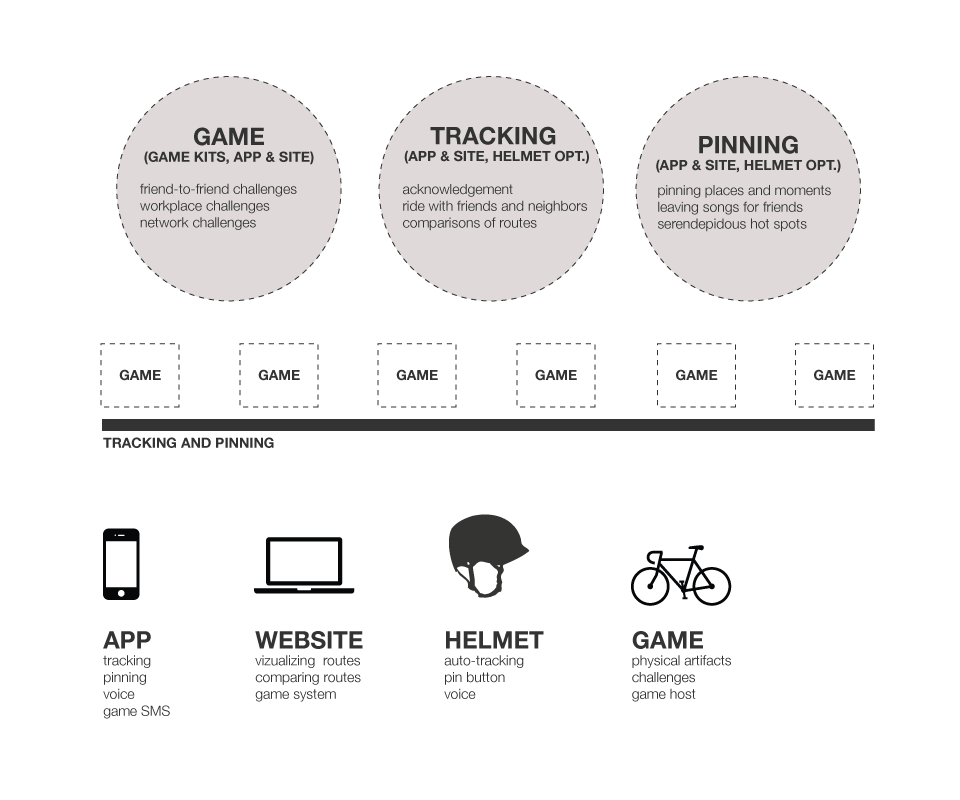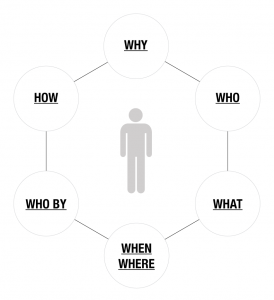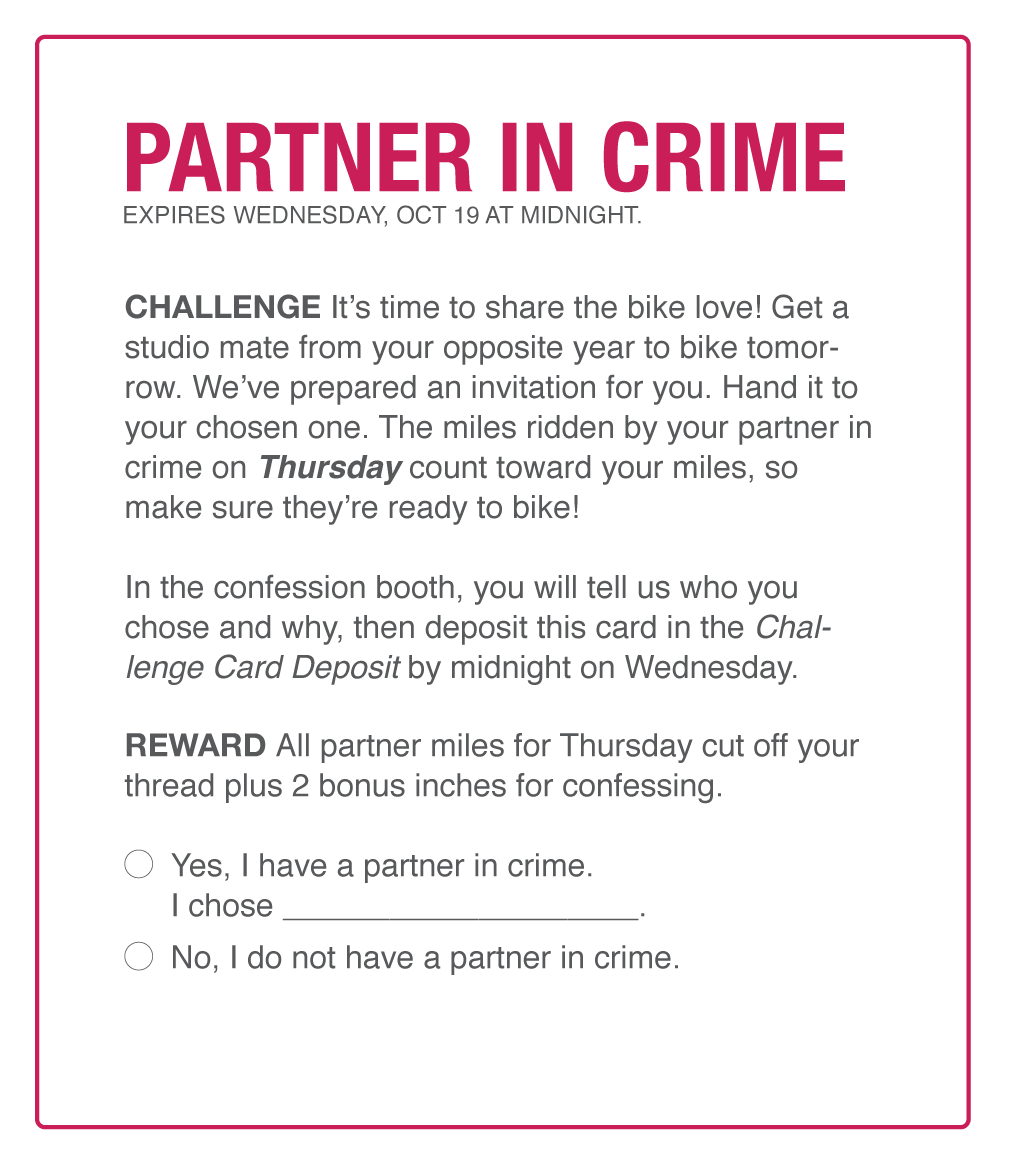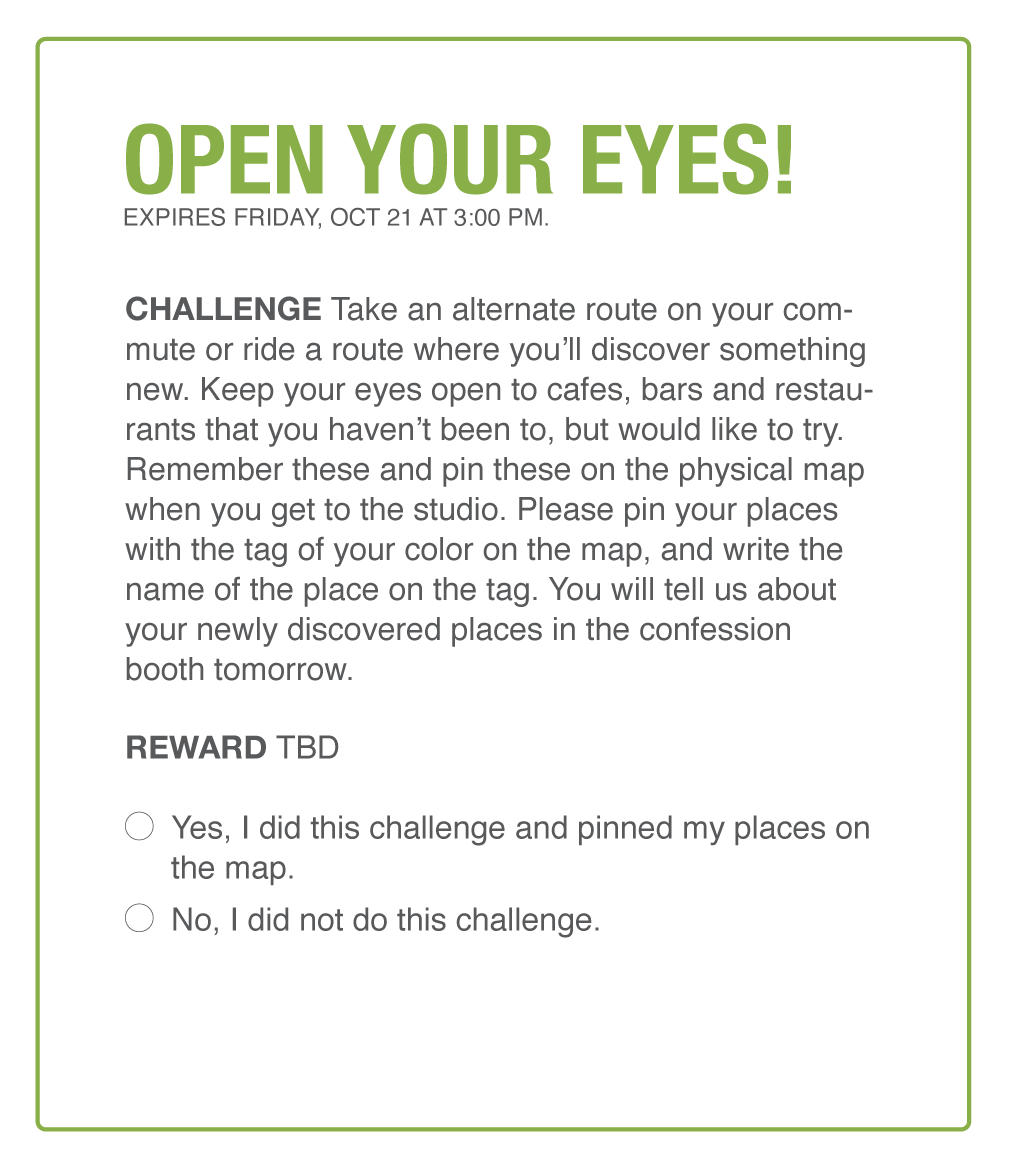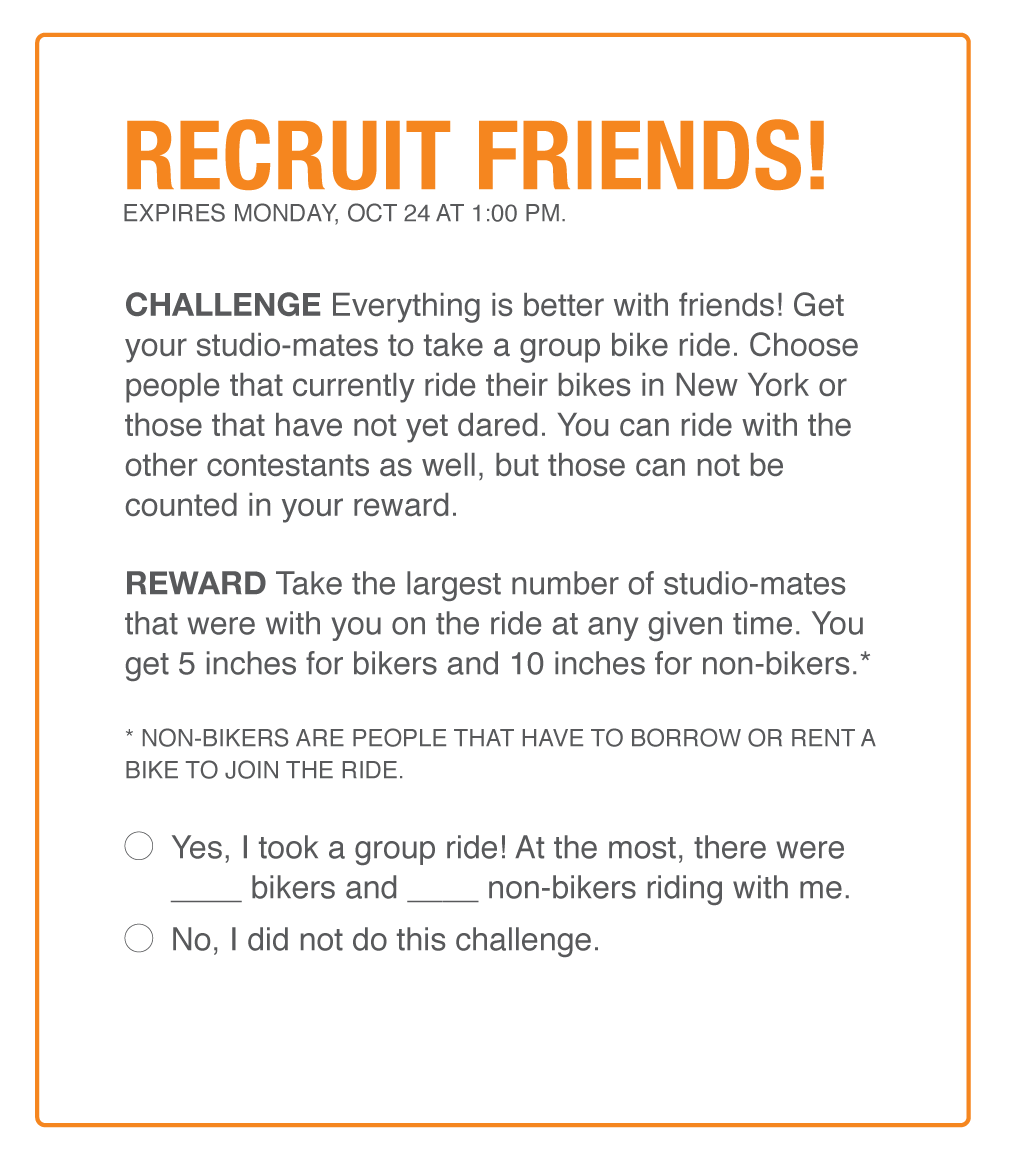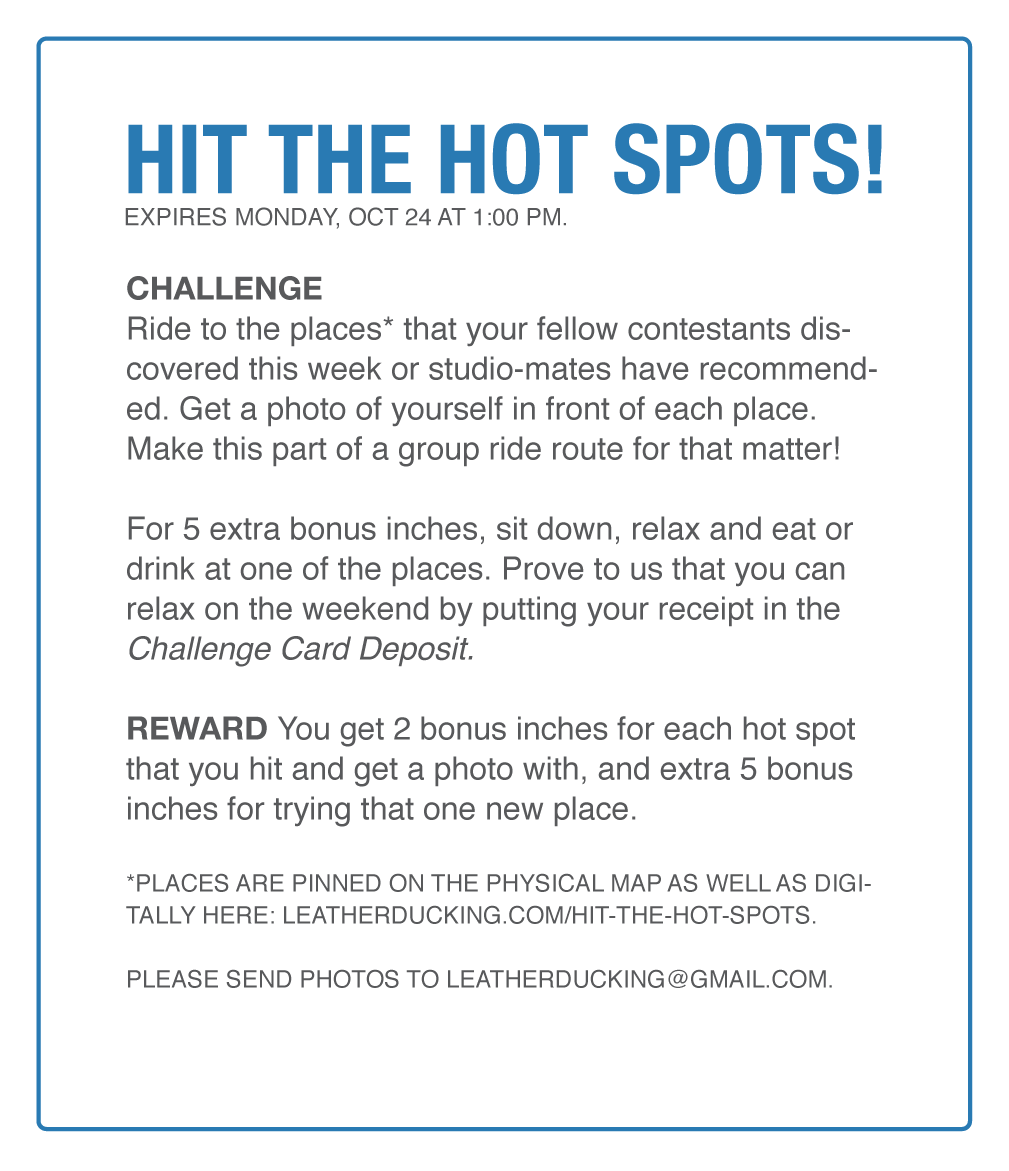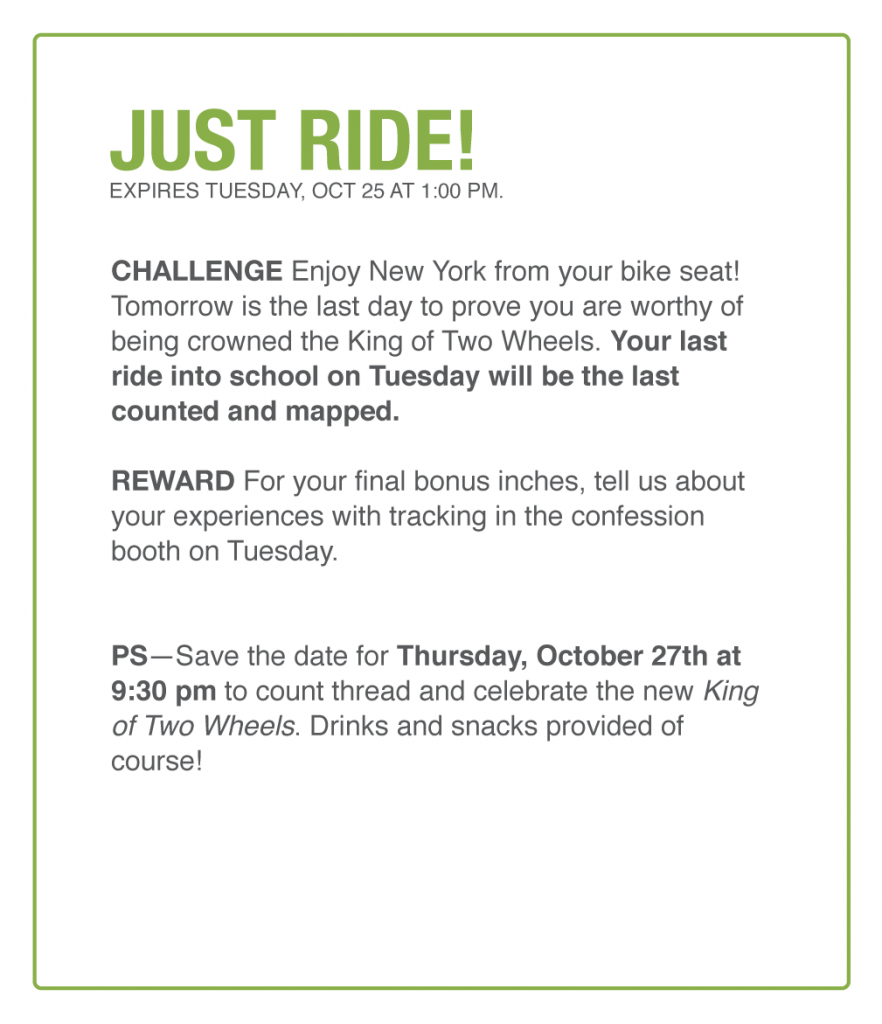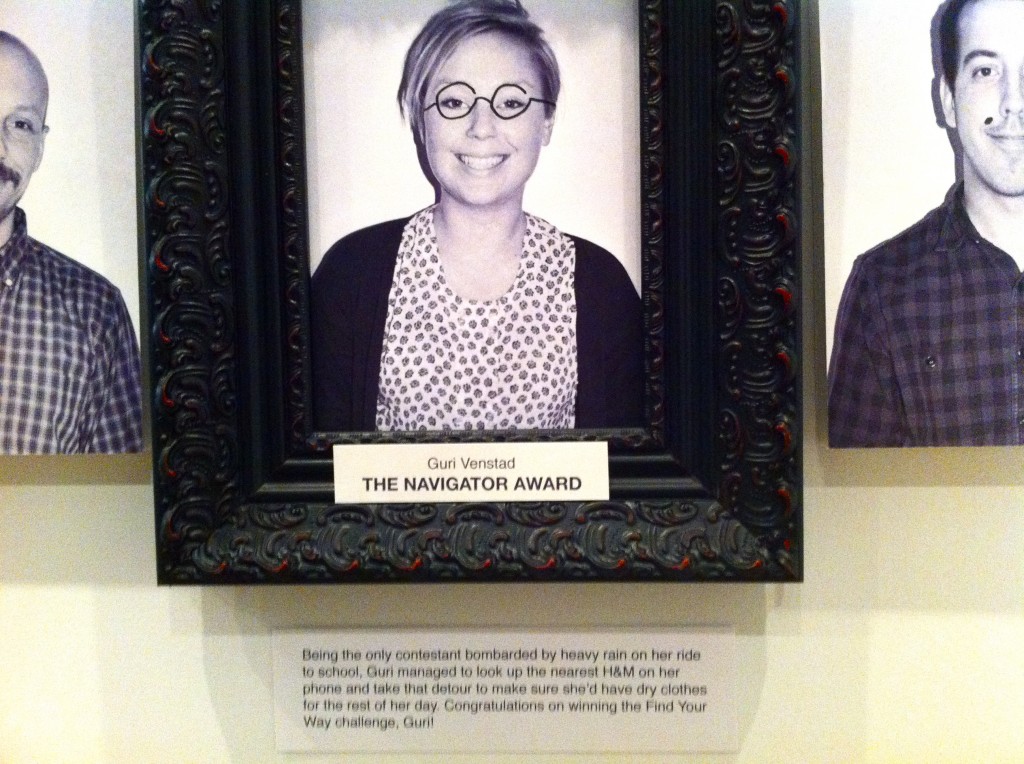This is a first shot at mapping our concept as it stands now. Gaming, tracking and pinning are the primary features. Tracking and pinning happen consistently, while games take place periodically. A mobile app, website, bike helmet and game system make up the service.
Author Archives: Carrie Stiens
Four Traits of a Game
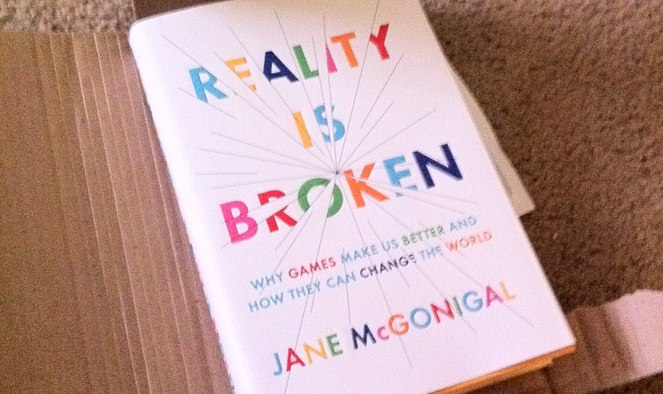
One way of motivating people to do things they didn’t really think they would do, is to make a game out of it. Gamification if you like. From Jane Mcgonigal’s book, I’ve found her defining traits of a game:
“The goal is the specific outcome that players will work to achieve.” It gives players purpose.
“Rules place limitations on how players can achieve the goal.” They push players to “explore preciously uncharted possibility spaces” and “unleash creativity and foster strategic thinking”.
“The feedback system tells players how close they are to achieving the goal.” This refers to points, a score, progress bar or levels. Real-time feedback pushes players.
“Voluntary participation requires that everyone who is laying the game knowingly and willingly accepts the goal, the rules, and the feedback.” It establishes common ground between players.
She says that everything else in games works to enhance these four primary traits. Wow.
Story Model, v.1
In my thesis workgroup, we are using a story model to help us delineate the intervention we are making with the thesis project. This is version one.
WHY: To create seamless and extra delightful bike rides
WHO: casual commuter, committed commuter, the ‘not yet convinced’
WHAT: framework/digital toolset for a better riding experience
WHEN/WHERE: during a ride, before and after a ride, ‘hunger moments’, planning periods
WHO BY: creators, bike nerd developers, bike community
HOW: mobile application paired with a physical helmet
Concepts worth thinking about:
- bike commuter bus, arranges friend meetups
- person becomes a ‘bookmark’ in the city
- auto-track behaviors
- compare miles with other interesting facts in person’s life
- use additional hardware forms to increase sensory feedback: vibrating wristbands, blinking light handlebar attachments
Prototyping Features, Options
Note: We will probably need to purchase a smartphone for prototyping. I’m leaning much more toward the Android, not because I’m bias to my personal phone, but because as a platform it seems much more open for hacking than the iphone.
PHYSICAL BUTTONS AND SENSORS FOR RIDER FEEDBACK
One option is to use a dev board to interface between the phone and extra components (button, force sensor, etc). This gives us room to play with various sensors that may be embedded into the helmet. Sparkfun has products that would help us with this. For example, here’s a serial modem that allows you to interface an Arduino board with the Android or iPhone through the audio jack. This car audio project, also connecting with the phone through the audio jack, demonstrates the beauty of a physical button paired with a mobile phone.
Note: Wires are required for the first two examples. I think this is okay for early prototypes, but in the end, we do want to be wireless.
An alternative route is to hack the existing button on a bluetooth headset (or audio headphones) and reprogram it to do different commands. There are several examples of people doing this type of hack to boost the volume of audio, and perhaps there would be some direct correlations for what we would need to do. This gives us less control over selecting physical components, but may be more simple.
WHAT TO DO WHEN THE BUTTON WORKS
There are a couple simple things the button could to in the beginning to test the feasibility and experience of considered features:
1. To pin places; “Remember this location (longitude and latitude)”
2. To start/stop tracking
AND FINALLY FOR TRACKING AND GEO-LOCATION SOFTWARE
To be determined…We need something simple and with an open API.
STARTING POINTS FOR ANDROID APP DEVELOPMENT
A first look at building and android app
Android development tutorial
A bit about the android location API
Another android development 101
Feedback Questions
Questions for feedback from the participants of the King of Two Wheels:
QUESTIONS FOR CONTESTANTS
1. What about the game (which elements) made you bike more during the challenge?
2. What did you do, in regards to biking, during the game week that surprised you?
3. What did you enjoy about the game? What was delightful?
What did you not enjoy?
4. Which challenge did you enjoy the most?
5. Why did you do the challenges?
6. Which parts of the game got you excited vs. feeling like you just had to do them?
7. On a scale of 1 to 10, how aggressive were you in your efforts to win the game? Why or why not?
8. From your perspective, how aware of the game were your classmates?
9. What was confusing about the game?
etc.
QUESTIONS FOR PARTNERS
1. How did you respond to the invite? (excitement, confusion)
2. What was your perception of what the game was about?
3. What made or didn’t make you feel a part of the game?
4. How clear were the objectives of the game?
5. What did you feel like your role in the game was?
6. Why did or didn’t you place a bet?
etc.
Thesis Proposal, v.2
Our intention is to increase ridership and make trips seamless for bikers in urban areas. We recognize that people love to bike in the city but there are also many hassles and pain points that keep people from riding. Taking the bike is both good for human health, the environment and the economy. We want to help people stay on their bikes and encourage the ‘not yet convinced’ that biking is a viable mode of transportation.
ELEVATOR PITCH
We are making a digital toolset embodied in a physical helmet to be used by urban bikers that allows for a seamless riding experience. It will provide spoken directions, track riding habits and facilitate documentation of trips and communication with friends. Unlike a high-tech GPS bike computer, it has a charming personality and is geared towards the casual biker rather than the cyclist pro.
OUR FOUR MAIN CONCEPTS
Way-finding knowing where to go and how to get there, alleviating the stress of navigating while on your bike in a chaotic city
- find a safe route
- change suggested mode
- write your own route, list waypoints
- change suggested mode
- say when there’s bike lane and which side of road it’s on
- warn people of bumpiness
Discovery helping people remember and experience the interesting places they see on their rides (cafes, bars, restaurants, etc.), suggesting new places to visit.
- allow users to log their favorite places
- push button or voice command to pin location on a map
- consider integration with Yelp and/or Google Places
- plug into reviews from Yelp and/or Google Places
- learn preferences of rider
- provide commentary on sites
- opt into ‘wander mode’
- localized itineraries
- suggest a near destination
- allow people to say ‘I have 2 hours. Take me somewhere…!’
Tracking documenting where riders have been, revealing patterns in biking behavior, helping people feel proud of accomplishments and encourage sharing their progress
- sensor in helmet to auto-track when you sit on the bike seat
- put context around data, compare and contrast
- use variety when giving stats to make it meaningful
Motivation providing a way for riders to challenge people to ride their bikes, using social pressure, coordinating rides
- compare trips with your friends
- read aloud SMS from friends
- notify friends when rider gets on the bike to ride
- suggest and facilitate riding with friends and/or group rides
- facilitate conversation and competitiveness between users
- facebook sharing
- tweet about trip to bike community #BikeNYC
- report stories and funny encounters
- site specific encouragement and stories
- play music from local bands performing that week
- let people listen to their own music
INTENDED AUDIENCE
Intermediate riders
People currently biking in the city. They might already use navigational tools like bike maps and apps, and are searching for new ways to make their trips more seamless whether they want to get from A to B or wander.
Beginner riders
There’s a difference between knowing how to ride a bike, and being confident riding in an urban environment. Beginner riders might use their bike for recreational trips and are not yet convinced that biking can be a viable transit option.
Tourists on bikes
People that want to explore a new city from the bike seat. Might rent bikes from bike shops, or using bike share programs.
CONTEXT OF PROJECT
The bike community
Open Plans, Bike Share, Ride the City, Transportation Alternatives, New York City DOT, Bike Tech Meetup, Bike activists (bloggers, political figures, etc.)
Bike Tools
mobile apps that track behavior, apps aiding navigation, bike computers for pro cyclists, GPS for bikers (TOM TOM has turn by turn voice directions in Europe)
Products with related concepts
Motivational, data sharing, storytelling, creative personalities, way finding, trip planning, etc.
Websites and apps: Weight Watchers, RunKeeper, Nike+, Daytum, OpenTripPlanner, TripAdvisor, Yelp, Tamagotchi etc.
INTENDED FORM AND EXPERIENCE
The form of the product is a helmet with speakers, mic, sensors and buttons along with a mobile app. It is a friendly and delightful product that is aware of what the biker needs and when, alleviates stress from biking in chaotic surroundings, eases the process of using your bike for transit and inspires discovery of new places.
Progress Plan, v.2
ACHIEVED SO FAR
- Create a journey map
Zoom out and identify pain points and opportunities within the area of urban biking. - Create a conceptual model of project
Narrow in on a concept suitable for our thesis - Host King of Two Wheels bike challenge
Organize a bike challenge in the studio to test concepts and conduct user research.
NEXT STEPS
- Conduct contextual research (November 3)
Continue to learn about projects with similar concepts and features - In-Ride-Experience MVP (November 1-30)
Choose a route, get people to ride it, ride behind them while providing voice directions and testing main concepts. - Develop an MVP (November 15-December 19)
Software: Creating a web app for a user to input start and end point, and get directions through voice.
Hardware: R&D for speakers, bluetooth, button, sensors, and connecting these pieces to each other and the app. - Pitch video (by Christmas)
Show our product and it’s features. Purpose is to get our ideas out there, get feedback and solicit help with our next steps and development. - Redesign blog (by Christmas)
Get our blog in shape with a nice visual profile.
Christmas Break
- Define Alpha prototype (January)
Which features and what technology - Build Alpha prototype (January-April)
Make the technology work
Design interface with mobile app
Design interface with helmet
Develop personality, language and visuals
Spring Break (March 2-11)
SXSW (March 9-13)
- Release Alpha prototype (mid-March)
release prototype for 4-8 people to test - Iterate on Alpha prototype (mid-March-April)
- Documentation (mid-March-April)
Graduation (early May)
King of Two Wheels Challenges
Game Rules of King of Two Wheels
Hello there. At the launch of the King of Two Wheels bike challenge, we got together with the contestants to toast in bubbly and review the following game rules.
King of Two Wheels
The SVA Ixd Community Bike ChallengeWelcome. You are competing to become the King of Two Wheels of the SVA IxD studio. Prepare to bike a lot and to be bet upon by your studio mates. The final winner will be honored on the studio kitchen Wall of Fame, as well as be celebrated along with the other contestants at the King of Two Wheels finale party. The winner will also be treated to a complimentary, candle-lit, crock-pot dinner following the competition.
OBJECT OF THE GAME
Have the least amount of thread on your spool at the end of the game.HOW TO WIN
There are two ways to dwindle your thread—(1) map your rides with your thread or (2) earn rewards to cut off thread through challenges.Map rides: For every mile you take on your bike throughout the duration of the game, map it. Be as specific as possible with your route. You are welcome to use digital tracking apps to assist with this. And it may even help you score extra points later in the game.
Earn rewards: You get rewards by doing challenges. Challenges will involve a bike-related activity and a report (or confession) about your experience.
CHALLENGES
Challenges spur you to try new things and to encourage you to reveal your biking stories and strategies. Trying new things will happen on the streets of New York; Revealing biking stories and strategies will happen in the ‘King of Two Wheels’ confession booth.REWARDS
There will be daily winners and a final winner – the SVA IxD Bike King. For each challenge completed, there will be rewards in form of inches of thread cut of your spool. The scoring and rewards of challenges differ based on its nature. Some daily challenges are judged by the quality of your confession. Challenge winners are honored by day on the studio Wall of Fame.CONFESSIONS
First and foremost, we want you to have fun! Our second want is to capture your insights as New York bikers. The confession is a place for you to record your thoughts based on some questions we put on the wall. Talk to the camera in the booth as you would with your nice game administrators. Talk about what you encounter while biking, your strategies for finding your way on a bike in NYC, and what motivates you to get your bottom on the bike seat.TRUST
This game operates on trust. Yes, trust. Please be honest about your miles. And please keep your nose to yourself in the confession booth.DURATION
The duration of the game is one week. It starts Tuesday Oct 18th and lasts until Tuesday Oct 25th at 1:00PM. Your two-wheel enthusiasm should last forever.Please be safe out there on the road. We are not liable for any incidents on the road.
May the best rider win!
Carrie & Kristin
Behavior Change and Motivation
Changes are hard to make. Whether it’s changing your diet or turning your transit mode from the subway to biking, we as humans we need other people to hold us accountable and help us adjust to new habits. That’s why behavior change comes best through the support of community. On the last jaunt with strangers that ride bikes, Tour de Taco, this is something that I learned, again. While each biker was on the group ride for various reasons, some were there to get back into biking. I talked with two specific bikers that previously pedaled to work, but had stopped, for their own respectable reasons. They both confessed, in their own words, that they came to get their butts on their bikes again. Basically, they forced themselves to be surrounded by a lot of people doing the very thing they wanted to be doing.
We previously launched the King of Two Wheels. We’re challenging four contestants within a community of 30 SVA IxD grad students to bike more than usual for one week, track their miles on a shared map, discover new parts of the city and to recruit others to join them. The King of Two Wheels will be our first experiment with learning how people are motivated to ride. Through it, we hope to get people talking about and doing more biking, while gaining insights into their habits, tips and tricks, and motivations.
We put out eight challenges within the week of the contest. Along with these, we had multiple strategies to get them motivated and biking more:
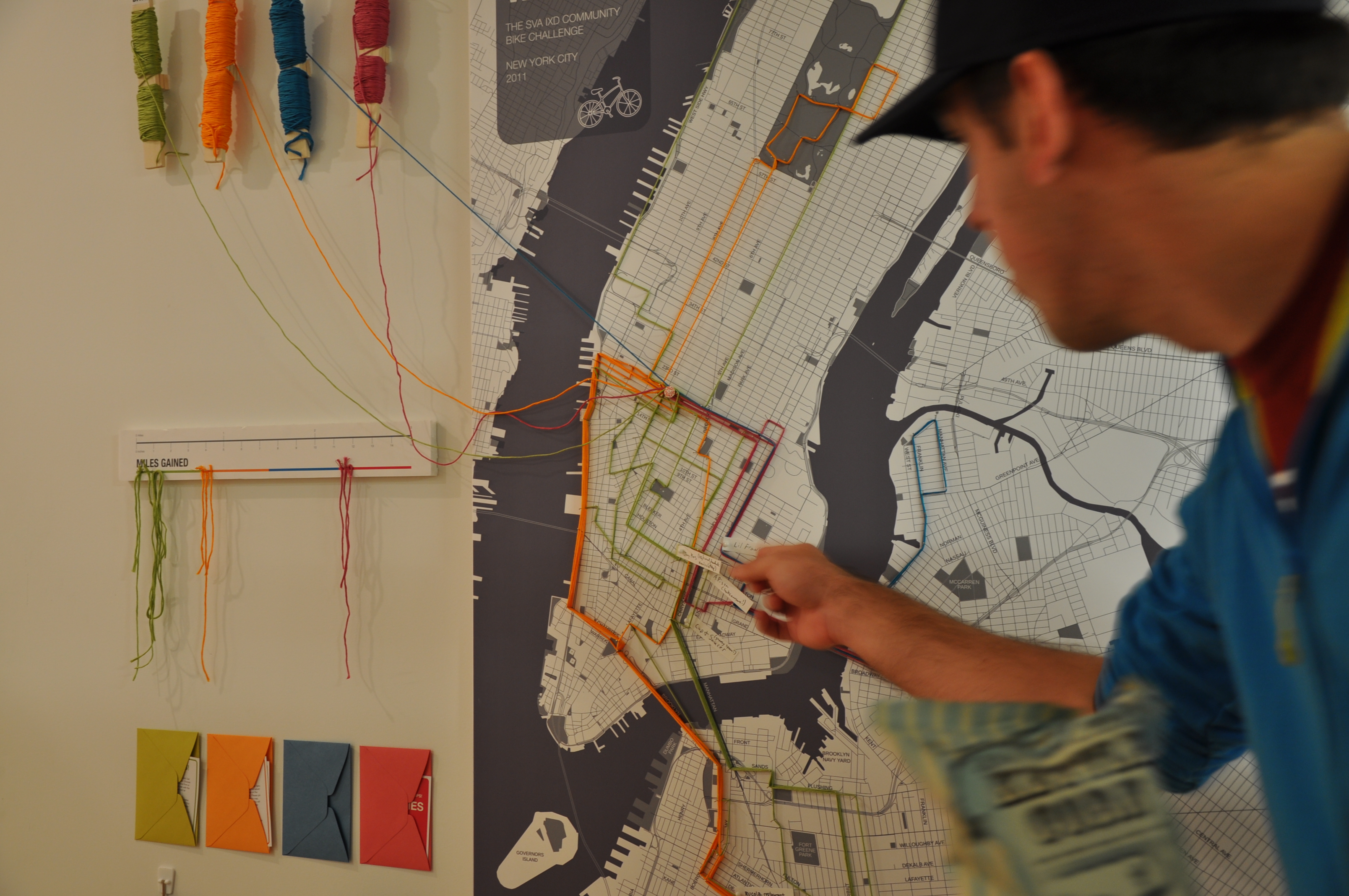 Map rides on a shared map to document progress and compare achievements.
Map rides on a shared map to document progress and compare achievements.
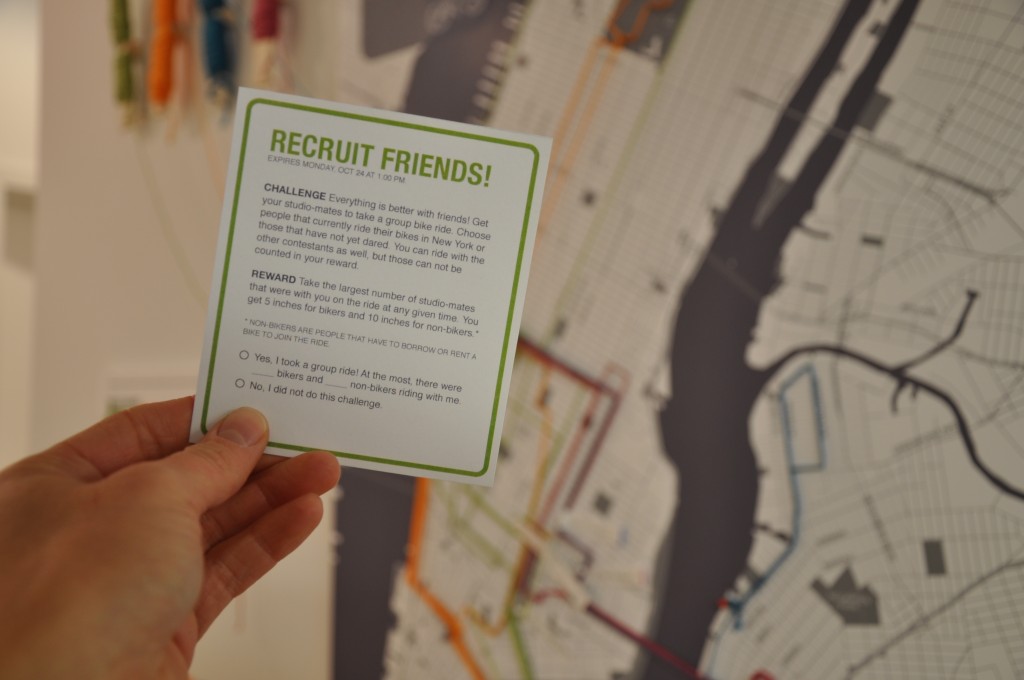 Prompt riders to recruit friends to get the community involved organically.
Prompt riders to recruit friends to get the community involved organically.
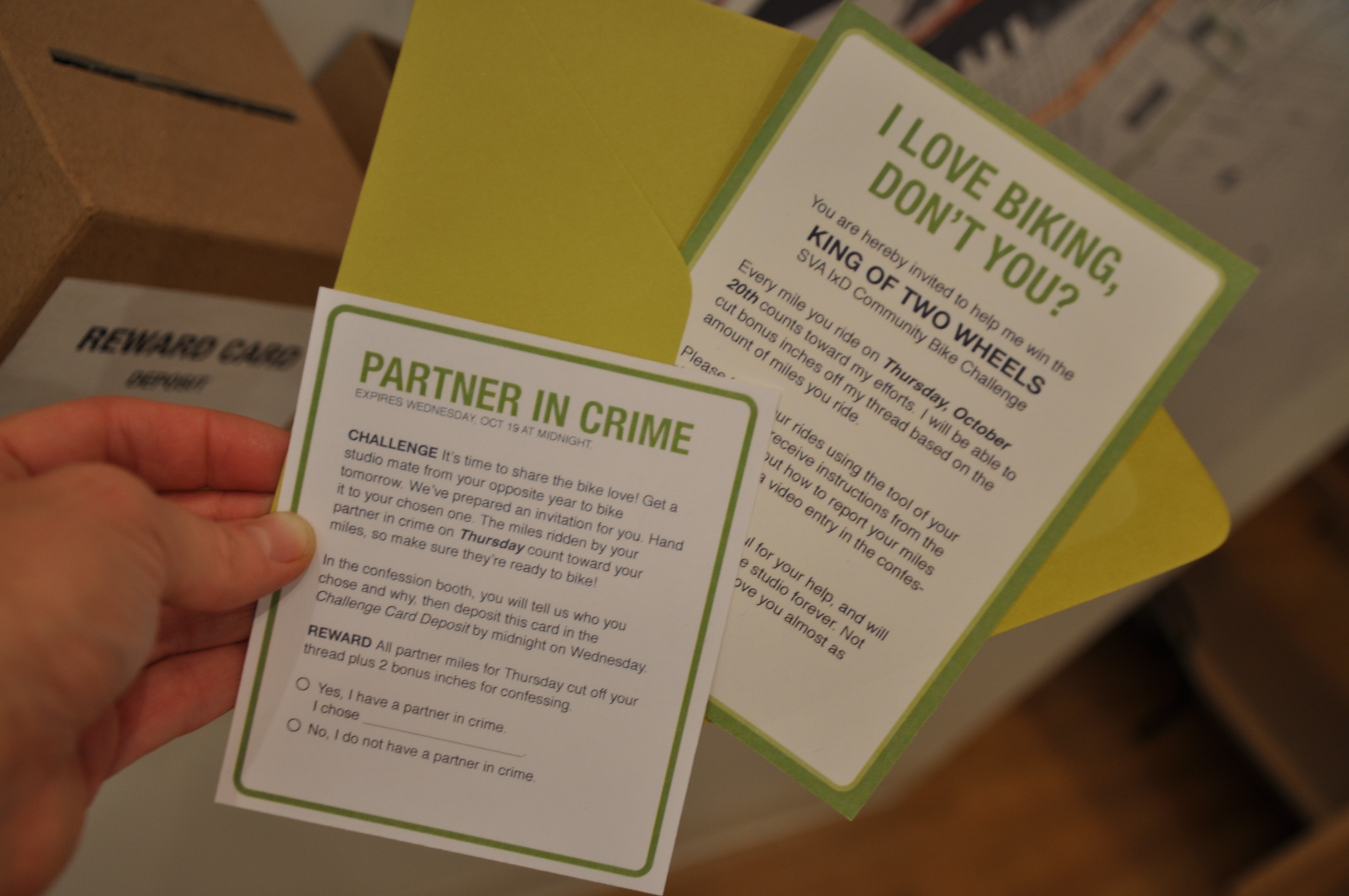 Invite riders to get a team mate for the day.
Invite riders to get a team mate for the day.
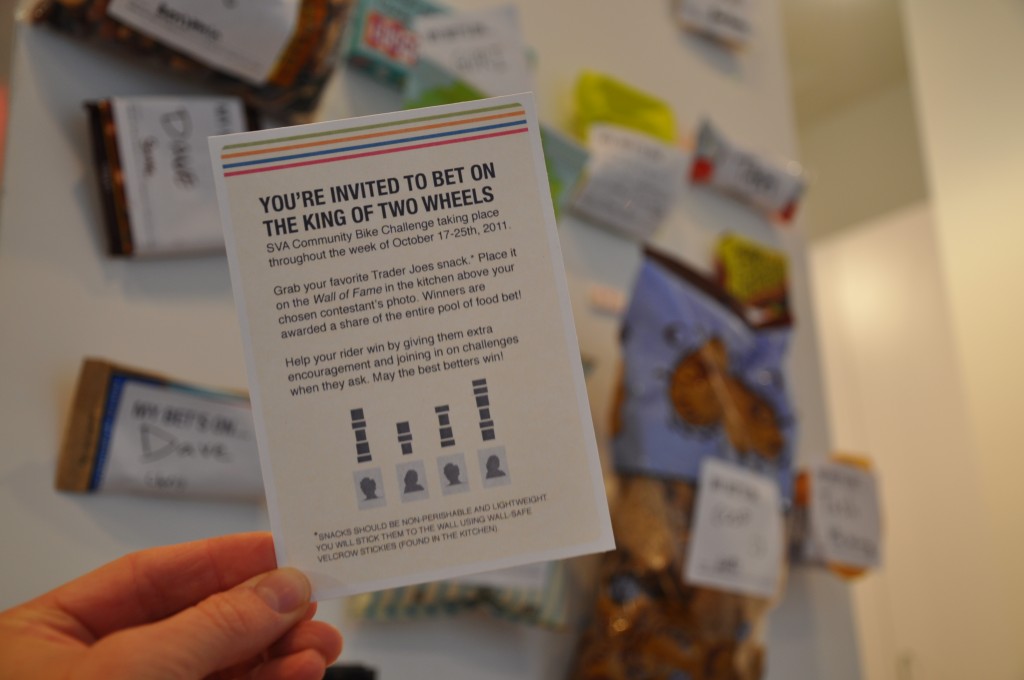 Invite the community to bet on their chosen contestant to win
Invite the community to bet on their chosen contestant to win
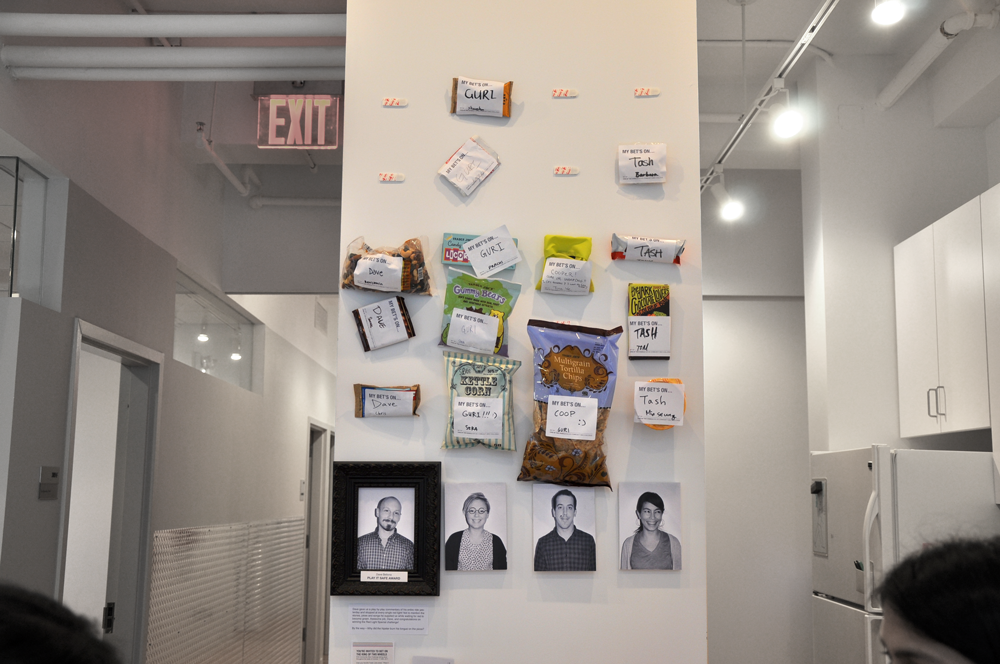 …and using the bets as a visual bar chart display in a common area.
…and using the bets as a visual bar chart display in a common area.
